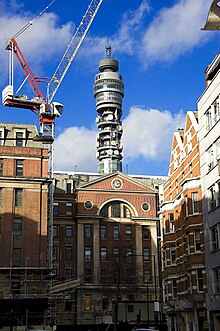Middlesex Hospital Medical School
| Middlesex Hospital | |
|---|---|
 |
|

The hospital in September 2007, shortly before demolition
|
|
| Geography | |
| Location | Fitzrovia, London, England |
| Organisation | |
| Care system | NHS England |
| Hospital type | General |
| Affiliated university | University College London |
| Services | |
| Emergency department | No |
| History | |
| Founded | 1745, moved 1757, rebuilt 1928 |
| Closed | 2005 |
| Links | |
| Lists | Hospitals in England |
The Middlesex Hospital was a teaching hospital located in the Fitzrovia area of London, England. First opened in 1745 by Edinburgh Medical School trained surgeon Charles Bell on Windmill Street, it was moved in 1757 to Mortimer Street where it remained until it was finally closed in 2005. Its staff and services were transferred to various sites within the University College London Hospitals NHS Trust. The Middlesex Hospital Medical School, with a history dating back to 1746, merged with the medical school of University College London in 1987.
The first Middlesex Hospital opened in 1745 as the Middlesex Infirmary in Windmill Street, London W1, named after the county of Middlesex. The infirmary started with 18 beds to provide medical treatment for the poor. Funding came from subscriptions and, in 1747, the hospital became the first in England to add 'lying-in' (maternity) beds.
The second Middlesex Hospital, in Mortimer Street, was opened in 1757. The foundation stone was laid in 1755 by the hospital's president, the Earl of Northumberland. The Hospital was Incorporated by Act of Parliament in 1836, allowing it various benefits as a charity.
Over the years extra wings were added but, in 1924, it was decided that the building was structurally unsound and an entirely new building would be required. The Duke of York, later King George VI, visited the hospital on 26 June 1928 to lay the foundation stone of the new building. He returned to open the completed building on 29 May 1935. The hospital had been completely rebuilt, on the same site and in stages, without ever being closed, paid for by more than £1 million of donations from members of the public. The nurses' home in Foley Street was connected to the hospital by underground tunnels to allow safe and convenient access for nursing staff at night.
Whilst part of the Bloomsbury Health Authority in the 1980s, the Middlesex Hospital was also associated with: St. Peter's Hospital, Soho (urology); St. Paul's Hospital, Red Lion Square (skin and genito-urinary diseases); Soho Hospital for Women (gynaecological disease); Horton and Banstead hospitals (psychiatric disorders); Athlone House (geriatric care); St. Luke's (Woodside) Hospital (psychiatric disorders).
...
Wikipedia
